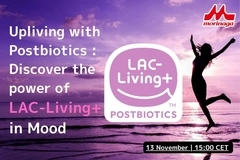Chr. Hansen edges closer to replicating breast milk with HMO blend study
26 Aug 2021 --- A new study has found a mix of the five most abundant Human Milk Oligosaccharides (HMOs) in natural concentrations is safe and tolerable in infant formula.
The study also revealed that infants who consumed the HMO blend produced softer stools at a higher frequency than the control formula group, bringing them more on par with the breastfed study group.
“This study is an important step to bring infant formula closer to breast milk,” says Jesper Sig Mathiasen, senior vice president, Chr. Hansen HMO.
Chr. Hansen has conducted the HMO scientific study of an infant formula containing the five most abundant HMOs: 2’-fucosyllactose, 3-fucosyllactose, lacto-N-tetraose, 3’-sialyllactose and 6’-sialyllactose.
The study was “well represented” by these five types, explains Dr. Katja Parschat, head of R&D, Chr. Hansen HMO, “since they account for about 30 percent of all HMOs in human breast milk.”
Putting it to the test
The multi-center, randomized, double-blinded study was conducted in 12 different investigator sites across Europe and included 341 newborn infants that were followed over a four-month investigational period.
All infants developed well and the formula containing the mix of the five HMOs in question was well tolerated.

 All infants in the study developed well and the formula containing the mix of the five HMOs in question was well tolerated.The results show good safety and tolerability in infants at a concentration of 5.75 g per liter (g/l), which resembles the concentration that is naturally found in mother’s milk.
All infants in the study developed well and the formula containing the mix of the five HMOs in question was well tolerated.The results show good safety and tolerability in infants at a concentration of 5.75 g per liter (g/l), which resembles the concentration that is naturally found in mother’s milk.
These results have just been published in the peer reviewed journal Nutrients, and it is the first publication describing the application of a complex blend of five HMOs at physiological concentrations.
Exploring diversity
It is a strategic priority for Chr. Hansen to invest in further research to expand its expertise in this innovative field and provide more insights on the benefits of HMOs in science and in infants’ health.
“Breastfeeding is the best way to ensure infant health and recommended by the World Health Organization (WHO), but at Chr. Hansen, we aim to support the healthy development of infants that cannot be breastfed by providing HMOs as an ingredient and blend for infant formula in a natural concentration,” adds Sig Mathiasen.
Parschat adds that many benefits of HMOs stem from the structural diversity.“ About 150 different HMOs have been identified so far, but most infant formula products do not contain HMOs or contain only the most abundant HMO, 2’-fucosyllactose.”
HMOs are authorized as ingredients for infant formula in North America, Europe, parts of Latin America and Asia with approvals pending in key markets such as China, India, Brazil and Argentina.
The tip of the iceberg
HMOs are the third most abundant components exclusively found in human breast milk. They are known to provide benefits to infants by supporting the immune system, promoting growth of beneficial gut bacteria and supporting brain development.
“In a further study, we will analyze the development of the gut microbiota of the 341 infants included in the study just published to get more insight on the benefits of the HMOs on gastrointestinal health,” she concludes.
Last year Chr. Hansen stepped into the HMO category when it acquired Germany-based Jennewein Biotechnologie.
With the acquisition, Chr. Hansen inherited various legal disputes over copyright infringement of Jennewein’s HMO production technology. Those with Nestlé and Glycom have since been settled.
Edited by Missy Green

















